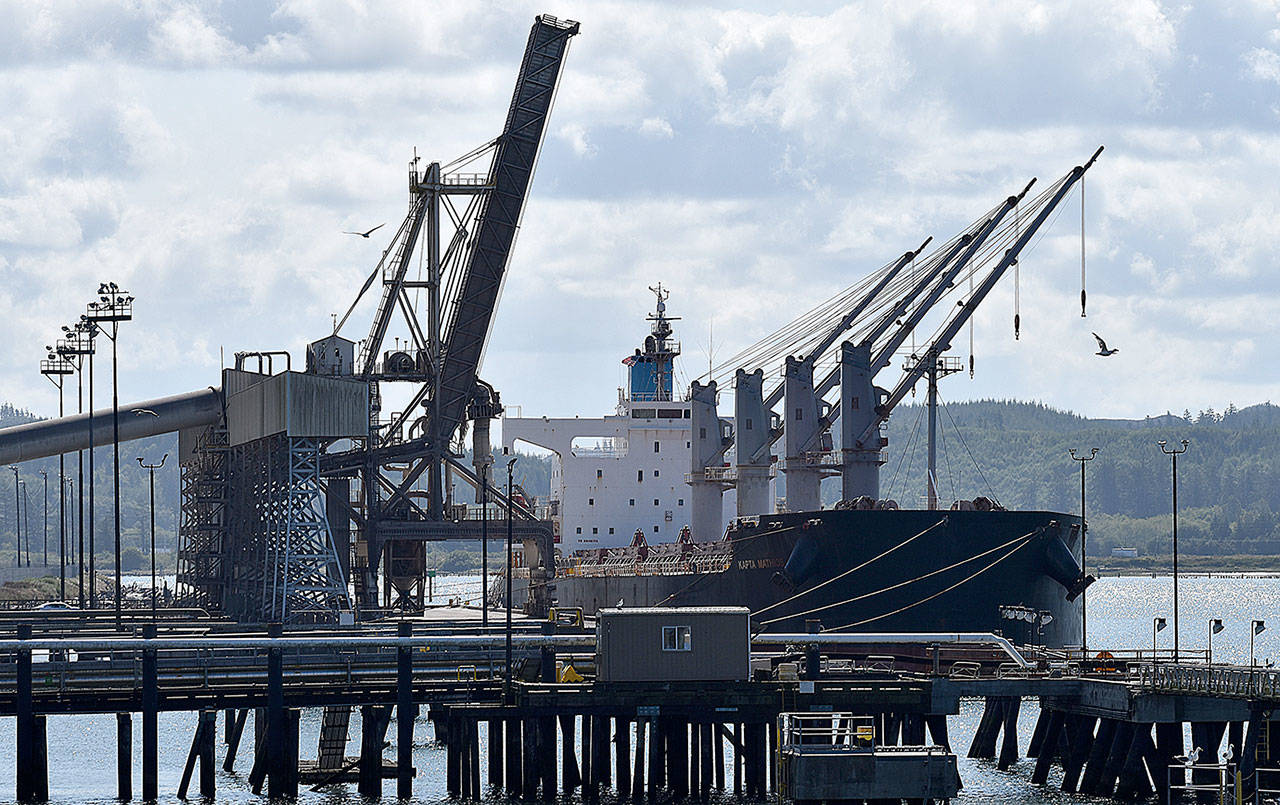The Port of Grays Harbor continues to move hundreds of thousands of tons of product a month through its terminals, and set a record for most volume in July at Terminal 2.
“In July 2020 we have seven ships and one barge,” Port Deputy Executive Director Leonard Barnes told the Port Commission earlier this week. “For the month, 222,609.384 metric tons went across the docks.”
For the year, 45 deep-water ships and 19 barges have called on the Port of Grays Harbor, and 1,622,070 metric tons of cargo went across the docks through the end of July.
“So far in August we’re off to a good start, continuing the strong July we had,” said Barnes.
Eight vessels are expected at the Port in August. According to the Port’s newsletter released earlier this month, seven are bound for Terminal 2, the location of AGP — Ag Processing Inc. — a farmer-owned cooperative that processes and transports grain and grain products.
“As a whole, AGP set a record in July for the most volume — 193,015 metric tons,” said Barnes. “That’s the most volume ever moved since 2002.”
AGP has been moving a lot of soy meal to overseas markets. When Port Commissioner Tom Quigg remarked about the “unusual” number of vessels he’s seen anchored waiting to enter the docks, Barnes said, “It brings back a lot of pride and great memories of the old days. It’s a reflection of the market. AGP is going strong.”
Barnes was quick to credit Port workers for their attention to detail, keeping anchored ships organized, and also for those working to keep the large number of rail cars coming into the Port with AGP product.
“Our pilot is doing a great job out there positioning the vessels safely, they’re very meticulous about that,” he said. “And in July, for AGP, we had over 2,000 rail cars. We had our team out there, and the longshoremen have been top notch. It takes a team, a real family, to get that done,” keeping rail cars moving safely and coordinating their arrival with the vessels coming to the docks and the work shifts that fill them with product.
That complicated dance includes USDA inspections for vessels carrying food products. Hoquiam resident Arnold Martin of Hoquiam asked the commission during the public comment period why he’d seen one vessel anchored outside the Port, only to go into the Port in the evening, and the next day it was once again anchored away from the docks.
“What happened with that vessel is they have the hold inspections by the USDA to certify the hold is clean and meets acceptance of food grade (products),” said Barnes. Some vessels choose to come in for that inspection ahead of their scheduled loading time at the Port. Once the inspection is complete, they anchor and await their turn.
“Not all vessels choose to do that,” said Barnes. “Some are inspected when they dock and ready to load, and some choose to do it ahead of time, go back out once the inspection is complete, then once they come in they can start loading right away.”
Current challenges
Ports are in transition as COVID-19 slowdowns in some sectors open up space at competing ports. Port Executive Director Gary Nelson provided some context and reasons the Port of Grays Harbor will remain focused on trade and marine terminals.
“Marine terminals and industrial properties are the only two lines of business we have that continually provide an excess revenue flow for us to provide the other services we do,” he said. Those other services include public access points at the Westport Marina and Friends Landing.
“We’re not in the cruise ship or container business, but with slowdowns in those sectors comes surplus space in other ports in metropolitan areas,” said Nelson. “That equates to more competition for automobile or transient cargoes.”
The cruise industry has been particularly hard-hit by the pandemic. In the past month, Seattle-based Holland America sold off four of its ships in the wake of COVID-19 shutdowns, and the Port of Seattle put plans for a new cruise terminal on hold back in April, and late in July halted its plan to seek out investors for the terminal.
As space lies vacant in other ports, those ports are making modifications and looking at ways to use that space to generate revenue.
“They’re looking at cargo that is more transient in nature: cars, break bulk, overheight, metals, things like that,” said Nelson.
The transient nature of automotive shipping was evident late last year when Pasha Automotive Services at Terminal 4 saw its Chrysler shipping contract move to a Portland location.
Nelson believes such transitions in ports will be temporary as the economy recovers and the higher end commodities take port space back.
As a result, the Port of Grays Harbor will continue to focus on the factors that have led to the Port’s success over the past 10-15 years, said Nelson, including “maintaining the things that give us a comparative advantage, typically infrastructure, typically transportation related.” Those factors include the Port’s rail access and maintaining the navigation channel.
“Don’t lose focus, preserve and protect the assets which give us the ability to respond, and stick to what works, that being using Port assets to leverage private investment, a model that has evolved over the years and proved to be very successful for us,” said Nelson. Barnes said, “It’s critical we don’t lose focus of marine dependant rail cargoes with partners willing to invest in our facilities.”
Local partnerships are key as well. Nelson said the Port’s relationship with the Quinault Indian Nation has grown over the past decade. “We’re learning to embrace our differences and finding a path forward,” he said. “We tried a lot of things that didn’t work or weren’t acceptable and we’re still trying to find a sweet spot that provides the treaty and environmental protections that are so important to the (Quinault Indian) Nation.”


